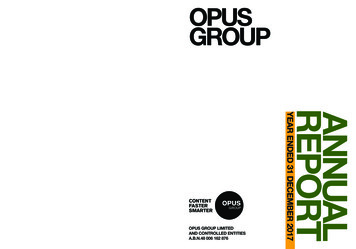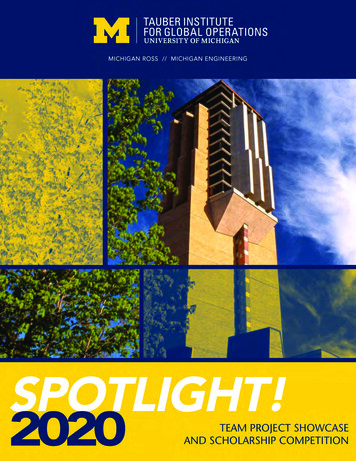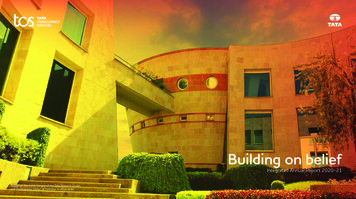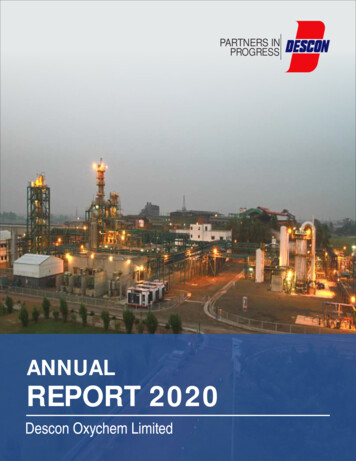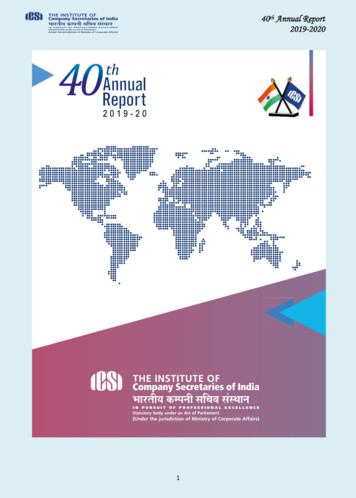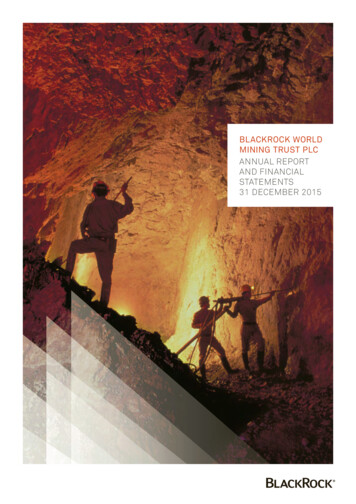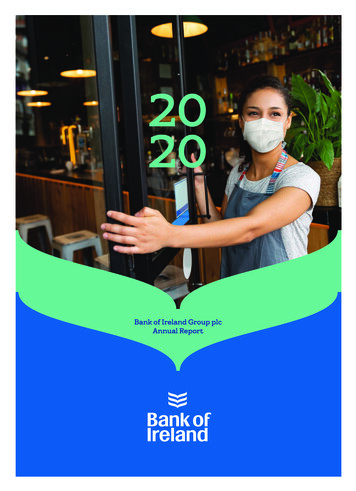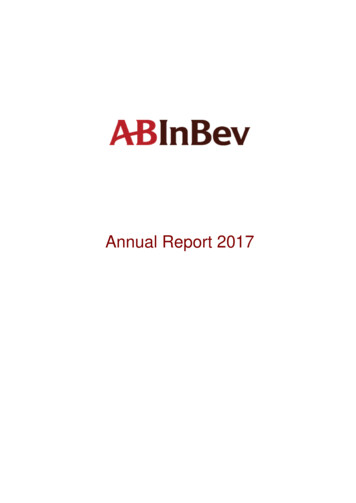
Transcription
Annual Report 2017
Financial ReportManagement reportAnheuser-Busch InBev is a publicly traded company (Euronext: ABI) based in Leuven, Belgium, with secondary listings on the Mexico(MEXBOL: ANB) and South Africa (JSE: ANH) stock exchanges and with American Depositary Receipts on the New York StockExchange (NYSE: BUD). Our Dream is to bring people together for a better world. Beer, the original social network, has been bringingpeople together for thousands of years. We are committed to building great brands that stand the test of time and to brewing the bestbeers using the finest natural ingredients. Our diverse portfolio of well over 500 beer brands includes global brands Budweiser ,Corona and Stella Artois ; multi-country brands Beck’s , Castle , Castle Lite , Hoegaarden and Leffe ; and local championssuch as Aguila , Antarctica , Bud Light , Brahma , Cass , Chernigivske , Cristal , Harbin , Jupiler , Klinskoye , MichelobUltra , Modelo Especial , Quilmes , Victoria , Sedrin , Sibirskaya Korona and Skol . Our brewing heritage dates back more than600 years, spanning continents and generations. From our European roots at the Den Hoorn brewery in Leuven, Belgium. To thepioneering spirit of the Anheuser & Co brewery in St. Louis, US. To the creation of the Castle Brewery in South Africa during theJohannesburg gold rush. To Bohemia, the first brewery in Brazil. Geographically diversified with a balanced exposure to developed anddeveloping markets, we leverage the collective strengths of nearly 200 000 employees based in more than 50 countries worldwide. For2017, AB InBev’s reported revenue was 56.4 billion US dollar (excluding joint ventures and associates).The following management report should be read in conjunction with Anheuser-Busch InBev’s audited consolidated financial statements.In the rest of this document we refer to Anheuser-Busch InBev as “AB InBev” or “the company”.COMBINATION WITH SABOn 10 October 2016, AB InBev announced the completion of the Belgian Merger and the successful completion of the businesscombination with the former SABMiller Group (“SAB”).The combined company has operations in virtually every major beer market and an expanded portfolio that includes global, multicountry and local brands, providing more choices for consumers around the world. Following the combinations with SAB, AB InBevbenefits from a geographically diversified platform, with a stronger presence in key emerging regions with attractive growth prospects,such as Africa and Latin America. The growth opportunities in these developing markets complement the stability and strength of thecompany’s strong existing presence in developed markets.As a result of the Belgian merger, which was the final step in completion of the combination, the former AB InBev merged intoNewbelco, and Newbelco has become the holding company for the combined former AB InBev and SAB groups. All assets andliabilities of the former AB InBev have been transferred to Newbelco, and Newbelco has automatically been substituted for the formerAB InBev in all its rights and obligations by operation of Belgian law. Newbelco has been renamed Anheuser-Busch InBev, and theformer AB InBev has been dissolved by operation of Belgian law.The shares in the former AB InBev were delisted from Euronext Brussels, the Bolsa Mexicana de Valores and the Johannesburg StockExchange. The new ordinary shares were admitted to listing and trading on Euronext Brussels, the Johannesburg Stock Exchange andthe Bolsa Mexicana de Valores at the opening of business in each market on 11 October 2016. In addition, ADSs trading on the NewYork Stock Exchange, each of which used to represent one ordinary share of the former AB InBev, now each represent one newordinary share, effective as of the opening of business in New York on 11 October 2016.The share capital of AB InBev now amounts to 1 238 608 344 euro. It is represented by 2 019 241 973 shares without nominal value, ofwhich 85 541 785 are held in treasury by AB InBev and its subsidiaries as at 31 December 2017. All shares are new ordinary shares,except for 325 999 817 restricted shares.Following the combination, AB InBev is consolidating SAB and reporting the results of the retained SAB operations in its incomestatement as of the fourth quarter 2016.RECENT EVENTSCompletion of the disposal of the former SAB Central and Eastern European businessOn 31 March 2017, the company announced the completion of the divestiture of the businesses formerly owned by SAB in Poland,the Czech Republic, Slovakia, Hungary and Romania (the “CEE Business”) for a transaction value of 7.3 billion euro on a cashfree/debt free basis. The results of the CEE Business were presented as part of “Results from discontinued operations” until thecompletion of the disposal.Disposal of the company’s interest in Distell Group Limited to the Public Investment CorporationOn 12 April 2017, the company announced the completion of the sale of its entire indirect shareholding in Distell Group Limited tothe Public Investment Corporation Limited, acting on behalf of the Government Employees Pension Fund. The sale was required asa condition of the South African Competition Tribunal’s approval on 30 June 2016 of the business combination between AB InBevand SAB.Repayment of 8 billion US dollar Term Loan due 2021On 10 April 2017, the company repaid 6 billion US dollar of the 8 billion US dollar Term Loan due 2021. On 12 June 2017, ABInBev fully repaid the remaining 2 billion US dollar outstanding. This Term Loan was the last remaining facility of the 75 billionUS dollar senior facilities raised in October 2015 to finance the combination with SAB.1
Extension of 9.0 billion US Dollar 2010 senior facilitiesAB InBev extended its 9.0 billion US dollar 2010 senior facilities by two years, effective on 3 October 2017. The new maturity dateof the facility is 30 August 2022.Completion of CCBA disposalOn 4 October 2017, the company announced the completion of the transition of its 54.5% equity stake in Coca-Cola BeveragesAfrica (“CCBA”) for 3.15 billion US dollar, after customary adjustments. AB InBev stopped consolidating CCBA in itsconsolidated financial statements as of that date.CCBA, the largest Coca-Cola bottler in Africa, was formed in 2016 through the combination of the African non-alcohol ready-todrink bottling interests of SAB, The Coca-Cola Company and Gutsche Family Investments. It includes the countries of SouthAfrica, Namibia, Kenya, Uganda, Tanzania, Ethiopia, Mozambique, Ghana, Mayotte, and Comoros.Following completion, CCBA will remain subject to the agreement reached with the South African Government and the SouthAfrican Competition Authorities on several conditions, all of which were previously announced.In addition AB InBev and The Coca-Cola Company continue to work towards finalizing the terms and conditions of the agreementfor The Coca-Cola Company to acquire AB InBev’s interest in, or the bottling operations of, its businesses in Zambia, Zimbabwe,Botswana, Swaziland, Lesotho, El Salvador, and Honduras. These transactions are subject to the relevant regulatory andshareholder approvals in the different jurisdictions.Combination of the AB InBev and Anadolu Efes Russia and Ukraine businessesOn 9 August 2017, the company announced it had reached a non-binding agreement with Anadolu Efes (IST: AEFES), the leadingbrewer in Turkey, regarding a 50:50 merger of AB InBev’s and Anadolu Efes’ existing Russia and Ukraine businesses.The announcement of this non-binding agreement follows AB InBev’s acquisition of a 24% stake in Anadolu Efes as part of thecompany’s combination with SAB, which completed in October 2016. The transaction remains conditional on the completion ofsatisfactory due diligence and is subject to regulatory approvals in Russia and Ukraine.This intended combination of the companies’ operations in Russia and Ukraine would strengthen the competitive position of bothAB InBev’s and Anadolu Efes’ brands in these markets, with the potential for further growth. The combined business’ ambitionswould be to lead the Russian and Ukrainian markets, with a diverse portfolio of brands and a broader range of beers for consumers.In addition, the combination would enhance AB InBev’s existing relationship with Anadolu Efes and the value of its stake inAnadolu Efes.Following the closing of the intended transaction, the combined business would be fully consolidated in the Anadolu Efes financialaccounts. As a result, AB InBev would stop consolidating its operations in Russia and Ukraine and account for its investmentresulting from this transaction under the equity method.The transaction is expected to complete during the first half of 2018. Until completion of the transaction, both AB InBev andAnadolu Efes’ businesses in Russia and Ukraine remain separate and continue business as usual.Cervecería Nacional Dominicana S.A. (“CND”) put optionOn 1 December 2017, Ambev announced that E. León Jimenes S.A. (“ELJ”) partially exercised its option to sell approximately30% of the shares of Cervecería Nacional Dominicana S.A. (“CND”) for an amount of 0.9 billion US dollar. The put option wasincluded in the 2012 shareholders’ agreement between Ambev and ELJ. The transaction closed in January 2018 resulting inAmbev’s participation in CND increasing from 55% to 85%.Selected financial figuresTo facilitate the understanding of AB InBev’s underlying performance, the comments in this management report, unless otherwiseindicated, are based on organic and normalized numbers. “Organic” means the financials are analyzed eliminating the impact ofchanges in currencies on translation of foreign operations, and scopes. Scopes represent the impact of acquisitions and divestitures,the start-up or termination of activities or the transfer of activities between segments, curtailment gains and losses and year-overyear changes in accounting estimates and other assumptions that management does not consider part of the underlying performanceof the business.To facilitate the understanding of AB InBev’s underlying performance the company is presenting in this management report the2016 consolidated volumes and results up to Normalized EBIT on a 2016 Reference base and as such these financials are includedin the organic growth calculation. The 2016 Reference base includes, for comparative purposes, the results of SAB business fromthe 1st January 2016.The tables in this management report provide the segment information per region for the period ended 31 December 2017 and 2016in the format up to Normalized EBIT level that is used by management to monitor performance. The differences between the 2016Reference base and the 2016 income statement as Reported represent the effect of the combination with SAB. The profit, cash flowand balance sheet are presented as Reported in 2016. The results of the CEE Business were reported as “Results from discontinuedoperations” until the completion of the disposal that took place on 31 March 2017. The results of Distell were reported as share ofresults of associates until the completion of the sale that occurred on 12 April 2017, and accordingly, are excluded from normalizedEBIT and EBITDA. Furthermore, the company stopped consolidating CCBA in its consolidated financial statements as from thecompletion of the CCBA disposal on 4 October 2017.Whenever used in this report, the term “normalized” refers to performance measures (EBITDA, EBIT, Profit, EPS, effectiverate) before non-recurring items and discontinued operations. Non-recurring items are either income or expenses which dooccur regularly as part of the normal activities of the company. They are presented separately because they are important forunderstanding of the underlying sustainable performance of the company due to their size or nature. Normalized measures2taxnottheare
additional measures used by management, and should not replace the measures determined in accordance with IFRS as an indicatorof the company’s performance, but rather should be used in conjunction with the most directly comparable IFRS measures.The tables below set out the components of AB InBev’s operating income and operating expenses, as well as the key cash venue .Cost of sales .56 444(21 386)100%38%45 517(17 803)100%39%53 942(21 166)100%39%Gross profit .SG&A .Other operating income/(expenses) .35 058(18 099)85462%32%2%27 715(15 171)73261%33%2%32 776(18 111)85561%34%2%Normalized profit from operations (Normalized EBIT) .Non-recurring items .17 814(662)32%-13 276(394)29%-15 52029%Profit from operations (EBIT) .17 15230%12 88228%Depreciation, amortization and impairment .Normalized EBITDA .EBITDA .4 27022 08421 4298%39%38%3 47716 75316 3608%37%36%4 11319 6338%36%Normalized profit attributable to equity holders of AB InBevProfit from continuing operations attributable to equityholders of AB InBev.Profit attributable to equity holders of AB InBev .7 96714%4 85311%7 9687 99614%14%1 1931 2413%3%Million US dollar1Million US dollar20172016Operating activitiesProfit .Interest, taxes and non-cash items included in profit .Cash flow from operating activities before changes in working capital and use ofprovisions .9 18312 4842 76913 57221 66716 341Change in working capital.Pension contributions and use of provisions .Interest and taxes (paid)/received .Dividends received .Cash flow from operating activities .219(616)(5 982)14215 430173(470)(5 977)4310 110Investing activitiesNet capex .Acquisition of SAB, net of cash acquired .Net of tax proceeds from SAB transaction-related divestitures .Acquisition and sale of subsidiaries, net of cash acquired/disposed of.Net of tax proceeds from the sale of assets held for sale .Proceeds from the sale/(acquisition) of investment in short-term debt securities .Other .Cash flow from investing activities .(4 124)8 248(556)164 337(67)7 854(4 768)(65 166)16 342(792)146(5 583)(256)(60 077)Financing activitiesDividends paid .Net (payments on)/proceeds from borrowings .Other (including net finance (cost)/income other than interest) .Cash flow from financing activities .(9 275)(9 981)(1 748)(21 004)(8 450)62 675(3 494)50 731Net increase/(decrease) in cash and cash equivalents .2 2807641Turnover less excise taxes. In many jurisdictions, excise taxes make up a large proportion of the cost of beer charged to the company’s customers.3
Financial performanceGiven the transformational nature of the combination with SAB, that closed on 10 October 2016, the company updated its 2016segment reporting for purposes of results announcements and internal review by senior management. This presentation includes,for comparative purposes, the results of SAB from the 1st January 2016.AB InBev is presenting its results under six regions: North America, Latin America West, Latin America North, Latin AmericaSouth, EMEA and Asia Pacific.For further information on the basis under which the Reference Base was prepared, please refer to section Adjusted segmentinformation presented in the 2016 Management Report.The tables in this management report provide the segment information per region for the period ended 31 December 2017 and 2016in the format down to Normalized EBIT level that is used by management to monitor performance. To facilitate the understandingof AB InBev’s underlying performance the company is presenting in this management report the 2016 consolidated volumes andresults down to Normalized EBIT on a 2016 Reference base and as such these financials are included in the organic growthcalculation.The profit, cash flow and balance sheet are presented as Reported in 2016.The tables below provide a summary of the performance of AB InBev for the period ended 31 December 2017 and 2016 (in millionUS dollar, except volumes in thousand hectoliters) and the related comments are based on organic numbers.AB INBEV WORLDWIDE2016Reference BaseVolumes .Revenue .Cost of sales .Gross profit .SG&A .Other operating income/(expenses) .Normalized EBIT .Normalized EBITDA .Normalized EBITDA margin .615 88053 942(21 166)32 776(18 111)85515 52019 63336.4%Scope1CurrencytranslationOrganicgrowth(4 )362082551 0732 685(529)2 155288582 5012 5692017Organicgrowth %612 57256 444(21 386)35 058(18 099)85417 81422 08439.1%0.2%5.1%(2.6)%6.7%1.6%7.6%16.5%13.4%288 bpsIn 2017 AB InBev delivered normalized EBITDA growth of 13.4%, while its normalized EBITDA margin increased 288 bps,reaching 39.1%.Consolidated volumes grew by 0.2%, with own beer volumes growing 0.6% and non-beer volumes decreasing 3.1%.Consolidated revenue grew by 5.1% to 56 444m US dollar, with revenue per hectoliter increasing 5.1%. On a constant geographicbasis (i.e. eliminating the impact of faster growth in countries with lower revenue per hectoliter), revenue per hectoliter grew by5.1%. Combined revenues of the three global brands, Budweiser, Stella Artois and Corona grew 9.8% and 16.8 % outside of theirrespective home markets. Budweiser remains the world’s most valuable brand, generating strong results in China, Brazil and SouthKorea with 4.1% revenue growth. Stella Artois continued its long-term trajectory, with revenue growth of 12.8% driven by sales inNorth America, repatriation in Australia and its entry into South Africa and other new markets. Corona grew by 19.9% globally, ledby Mexico, China, Australia and Argentina.Consolidated Cost of Sales (CoS) increased by 2.6% and by 2.6% on a per hectoliter basis. On a constant geographic basis, CoS perhectoliter increased by 3.1%.VOLUMESThe table below summarizes the volume evolution per region and the related comments are based on organic numbers. Volumesinclude not only brands that AB InBev owns or licenses, but also third party brands that the company brews as a subcontractor andthird party products that it sells through AB InBev’s distribution network, particularly in Europe. Volumes sold by the GlobalExport business, which includes the company’s global headquarters and the export businesses which have not been allocated to thecompany’s regions, are shown separately.Thousand hectolitersNorth America .Latin America West .Latin America North .Latin America South .EMEA .Asia Pacific .Global Export and Holding Companies .AB InBev Worldwide .12016Reference BaseScopeOrganicgrowth2017Organicgrowth %116 890108 995119 75732 158134 821101 3201 939615 880423(98)(25)(4 157)148(673)(4 382)(3 817)1 729(358)1 9041 027518701 073113 496110 625119 37434 062131 692101 9861 336612 572(3.3)%1.6%(0.3)%5.9%0.9%0.5%5.5%0.2%See Glossary.4
North America total volumes decreased 3.3%. The company estimates that the United States industry beer sales-to-retailersadjusted for the number of selling days declined by 1.3%. On the same basis, the company estimates that its shipment volumes inthe United States and its beer sales-to-retailers declined by 3.5% and 3.0% respectively. The Above Premium brand portfolio had astrong year, gaining 45 bps of share. Michelob Ultra led the growth in this segment, with volumes up by double-digits, continuingits run as the top share gainer in the US for the eleventh consecutive quarter. Stella Artois had a solid year as well, gaining shareeach quarter. The regional craft portfolio also performed well this year, growing volume and share. In the Premium and PremiumLight segments, the company underperformed the industry with an estimated total market share loss of 40 bps for Budweiser and 85bps for Bud Light. Budweiser saw improved brand health and consideration trends, as it amplified key cultural moments throughoutthe year. While the company continues to face challenges on Bud Light, it saw some encouraging signs. In the second half of 2017,the brand was prevalent across US pop-culture with its highly popular “Dilly-Dilly” campaign, making it the leading beer in socialconversation in the fourth quarter and solidifying the brand’s “Famous Among Friends” positioning.Canada faced a challenging industry environment, however Bud Light remains the fastest growing brand in Canada, completing its22nd consecutive year of market share growth. The portfolio mix continues to improve, bolstered by growth in craft portfolio andStella Artois.Latin America West total volumes increased 1.6%. The company delivered another solid year in Mexico, with volumes up midsingle digits. The full brand portfolio performed well throughout the year. Victoria built upon its strong momentum, driven by theongoing success of its Mexican heritage positioning. Corona also performed well and Bud Light continued to grow volumesthroughout the country, leveraging successful sports and music activations. In Colombia, non-beer volumes performed very well,growing by 10.3% in the year as a result of commercial initiatives and a favorable comparable, while beer volumes declined by4.2% due to a challenging macroeconomic environment and tough comparable in the first half of 2017. Peru volumes were up lowsingle digits, as a result of the company’s commercial plans, with Cristal leveraging a key cultural moment by capitalizing on thecountry’s World Cup qualification. Ecuador’s volumes increased by low single-digits helped by packaging innovations as well asthe launch of the three global brands, the company gained share of total alcohol this year and offered consumers more choice acrossa variety of price points.Latin America North total volumes decreased 0.3%. The business in Brazil recovered well throughout the year and delivered itsstrongest results in the fourth quarter. For the full year, beer volume grew by 0.7% whereas the beer industry was slightly negativeand soft drinks volumes declined by 4.3%. The premium portfolio continued broad-based, double-digit growth this year fueled byour three global brands, especially Budweiser.Latin America South total volumes increased 5.9%. Argentina delivered a very strong performance, with volumes growing highsingle digit, fueled by the repositioning of Brahma as well as the successful launch of Quilmes Clásica and the accelerated growthof the premium portfolio led by Stella Artois, Corona and local craft brand Patagonia. The soft drink portfolio also performed wellas a result of a new commercial and portfolio strategy, achieving its best result in more than six years.EMEA total volumes increased 0.9% and own beer volumes increased 2.3%. In South Africa, beer volumes grew by 0.9%. Thehigh end portfolio, led by Stella Artois, Corona and the recent seeding of Budweiser, showed consistent growth in volumes andmarket share, finishing the year with triple-digit growth. In the near beer segment, Flying Fish recorded over 60% growth. In thecore plus segment, Castle Lite had another year of consistent growth. In Africa excluding South Africa, own beer volumes grew inthe mid-teens this year. Own beer volumes grew double digit in the majority of the markets, including Nigeria, Tanzania, Ugandaand Zambia as the company continues to expand the offerings to consumers through both affordability and premiumizationstrategies. Western Europe total volumes grew by 3.2%, achieving market share gains in the majority of the markets. The UKperformed especially well, resulting from a strong commercial performance mainly related to the company’s three global brands. InEastern Europe, total volumes declined by mid single digits this year driven by the ongoing headwind of the large PET ban inRussia affecting the total industry. However, global and premium brands performed well throughout the year.Asia Pacific total volumes increased 0.5%. In China, the company continued premiumization driving volume growth of 1.1% in anindustry that is estimated to have declined. The company’s brand portfolio benefited from strong consumer preference for premiumbrands. Budweiser grew nationally with some notable successes this year, including establishing itself as the leading beer brand insales in e-commerce while in the core plus segment, Harbin Ice outperformed the industry nationally. The super premium portfolio,led by Corona, Hoegaarden, and Franziskaner, accelerated its growth throughout the year, with volumes almost doubling versus lastyear, establishing the company as market leader in all super premium beer styles in China. In Australia, the Great Northernfranchise became the number one brand by volume this year as the company continues to fuel growth by addressing shiftingconsumer preferences. Global brands accelerated their growth throughout the year with volumes up in the mid-teens, driven bydistribution gains as well as commercial activations.OPERATING ACTIVITIES BY REGIONThe tables below provide a summary of the performance of each region, for the period ended 31 December 2017 (in million USdollar, except volumes in thousand hectoliters) and the related comments are based on organic numbers.AB INBEV WORLDWIDEVolumes .Revenue .Cost of sales .Gross profit .SG&A .Other operating income/(expenses) .Normalized EBIT .Normalized EBITDA .Normalized EBITDA margin .2016Reference Base615 88053 942(21 166)32 776(18 111)85515 52019 63336.4%ScopeCurrencytranslationOrganicgrowth(4 )362082551 0732 685(529)2 155288582 5012 5692017Organicgrowth %612 57256 444(21 386)35 058(18 099)85417 81422 08439.1%0.2%5.1%(2.6)%6.7%1.6%7.6%16.5%13.4%288 bps5
NORTH AMERICAVolumes .Revenue .Cost of sales .Gross profit .SG&A .Other operating income/(expenses) .Normalized EBIT .Normalized EBITDA .Normalized EBITDA margin .LATIN AMERICA WESTVolumes .Revenue .Cost of sales .Gross profit .SG&A .Other operating income/(expenses) .Normalized EBIT .Normalized EBITDA .Normalized EBITDA margin .LATIN AMERICA NORTHVolumes .Revenue .Cost of sales .Gross profit .SG&A .Other operating income/(expenses) .Normalized EBIT .Normalized EBITDA .Normalized EBITDA margin .LATIN AMERICA SOUTHVolumes .Revenue .Cost of sales
Completion of CCBA disposal On 4 October 2017, the company announced the completion of the transition of its 54.5% equity stake in Coca-Cola Beverages Africa ("CCBA") for 3.15 billion US dollar, after customary adjustments. AB InBev stopped consolidating CCBA in its consolidated financial statements as of that date.


